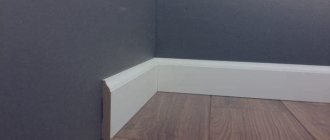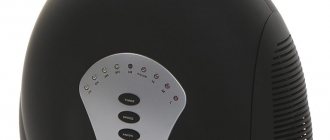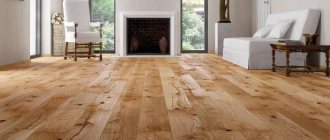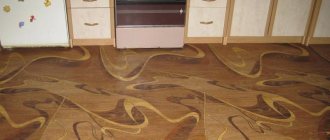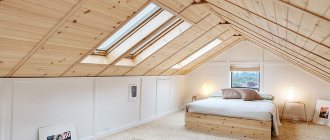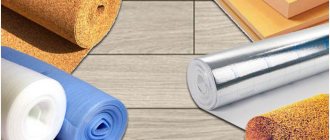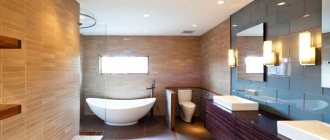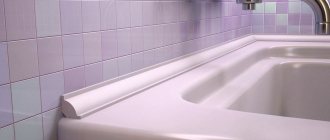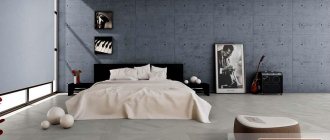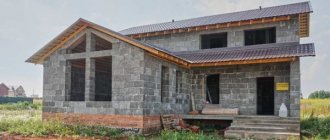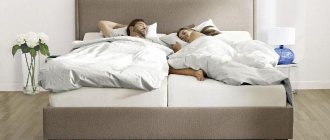Thin laminate: characteristics
The most cost-effective laminate options with a thickness of 6 millimeters can be found on the shelves of online retailers, which are the largest construction supermarkets. Their service life will be a couple of years under normal operating conditions. Such a laminate is unstable to moisture and mechanical stress, reacts with deformation of edges and abrasions, and has weak locking joints that are prone to the formation of cracks. Another disadvantage of thin laminate is the need for careful leveling of the floor, and therefore a large investment of time and consumables. It is useful for laying temporary floors.
Construction professionals recommend using a laminate with a thickness of at least 7 millimeters. It is suitable for bedrooms, offices and dressing rooms - rooms with reduced traffic load.
Selection of laminate according to SNiP requirements
The question of what thickness of laminate to choose for an apartment is decided depending on its immediate purpose, as well as in accordance with the requirements of Sanitary norms and rules. As for the utilitarian reasons for choosing this floor covering, these are:
- degree of load;
- the thickness of the floor itself;
- quality of preparation of the subfloor.
As for the requirements of SNiP, they are very diverse, but it is necessary to highlight 2 main directions that directly affect what thickness of the laminate should be in a given case. So, before laying it, it is imperative to check the quality of the subfloor in 3 directions, using a rule strip for this. In this case, the rule must be followed that the rack gap at no point should exceed more than 2 mm.
Before laying the laminate, you will need to check the quality of the subfloor in 3 directions, using a strip for this.
In addition, the floor should not have a slope level of more than 0.2%. Usually, these indicators are met by builders even at the stage of installing the rough floor covering, but if these conditions are not met, then when deciding what thickness of the laminate is better, you should take it 1-2 mm thicker than usual or choose a substrate for it that is approximately the same same thickness.
The floor should not have a slope level of more than 0.2%.
After the preparatory activities have been carried out, it will be necessary to calculate the thickness of the required material. To do this, take the amount of discrepancy, divide the subfloor into equal sections, and then lay additional layers of coating so that they reach the thickness you need. In this case, try to use the thinnest possible lining material for correction. Too thick will create air pockets in its thickness.
When deciding what is the best thickness of substrate for laminate, it is also worth considering some of the nuances of this type of finishing work. For example, if you select waterproofing for the floor that is a little thinner than recommended, also lay the underlay thicker by this amount. When using a bitumen-cork substrate, there is no need to use waterproofing, and if you decide to take it from woodworking products, then you will no longer need sound insulation. It is always worth remembering that most manufacturers state the maximum thickness of the laminate substrate is 5 mm, so it is better not to violate this figure.
If you select waterproofing for the floor that is a little thinner than recommended, also lay the underlay thicker by this amount
Thickened laminate: characteristics
Laminate with a slab thickness of 10-12 millimeters is a high-strength model. It has excellent sound insulation and moisture resistant properties. If heavy objects are dropped, thicker laminate boards are more likely not to leave dents. Thickened laminate flooring is used in hallways, kitchen areas, shops and offices with high traffic. It is adapted for increased motor load.
Laminate with a thickness of 10-12 millimeters, due to the size of the interlocking joints, fits more tightly and is suitable for laying on uneven surfaces. Especially in cases where repairs are done with your own hands without the involvement of construction specialists.
Laminate classes
Laminate 6 and 7 mm thick is produced only in class 32. Laminate with a thickness of 8-10 mm can be 32, 33 and 34 classes, 11 mm and 12 mm only 33 and 34 classes. When choosing a laminate for your apartment, it is better to opt for class 32, as it can cope with loads and is also more environmentally friendly. and class 34 are suitable for more walk-through (kitchen, corridor) and commercial (shop, office) premises.
How thick is laminate?
Laminate is divided into several classes, due to which it is possible to distinguish and indicate the level of wear resistance and the service life of the coating. Its thickness also largely depends on this.
The board is a multi-layer structure:
- The upper one does not affect the thickness, it is only responsible for wear resistance. Presented in the form of a laminating film made on the basis of melamine or acrylic. The purpose of the layer is to protect the lamella from mechanical influences, ultraviolet radiation, and high humidity.
- Decorative layer (located under the top one, also does not have a significant thickness). Presented in the form of foil or paper. It can be made in one tone or with a pattern that exactly imitates the texture of natural materials.
- The main layer is high-density wood board. the reliability of the locking system, the efficiency of installation work, the strength indicators and the practicality of using the coating in domestic and commercial premises depend on it
- The bottom layer is tarred kraft paper, the purpose of which is to protect the panel from a humid environment. It also prevents the possibility of friction between the board and the substrate, which in turn minimizes the premature destruction of the laminate.
Manufacturers offer three main classes of laminate , which vary both in physical and mechanical properties and in thickness. The product class indicates in what conditions the coating can be used, what loads it can withstand, and how long it will last.
So, what you need to know about the class of this flooring:
- Class 32 – varies from 6 to 7 mm , considered a budget coating option. Designed for domestic use in low-traffic areas (bedrooms, dressing rooms), as well as for commercial installation in low-traffic areas. Experts do not recommend laying laminate of this class throughout the entire apartment, as this will lead to the need for repeated repairs in the near future.
- Class 33 - standard coating, 8-10 mm , intended for installation throughout the house, as it can withstand high loads. If such products are selected for an office, then installation is possible in rooms with average traffic.
- Class 34 - laminate with a thickness of 10-12 mm , with enhanced properties. Laying such a coating is possible in corridors and areas with high traffic.
The last option is the most durable. Its strength indicators are superior to other options. Despite the high cost, the products pay for themselves due to durability and preservation of the original appearance for a long time.
But let’s just say from our own experience: for a simple apartment or house, 33 classes are quite enough.
Types and thickness of substrate
The thickness of the substrate under the laminate is usually 2-3 mm, less often up to 10 mm is used. The underlay allows you to smooth out uneven surfaces and increase the moisture and sound resistance of the floor covering. Two types of substrates have proven themselves well: polystyrene (Tuplex, Profitex) and cork; foamed polyethylene is less commonly used.
It should be borne in mind that the thickness of the substrate, combined with the thickness of the laminated board, can eat up several visually significant centimeters in rooms with low ceilings. As a rule, laying the laminate takes place last; here it is important to ensure that the door leaf opens freely. The use of different types of underlay helps to level out differences in flooring heights in adjacent rooms.
What does the thickness of the laminate underlay affect?
When laying a laminated floor, first lay a backing under the laminate (which underlay is best to use - find out here), which will level out small unevenness on the surface of the base and help protect the joints of the panels from breakage. The optimal thickness of the epigastric layer is 3 mm. A good quality underlay has good shock-absorbing properties and increases the level of noise insulation and thermal insulation of the floor covering.
Currently, there are quite a few varieties of backing material on sale, completely different in price and quality. There are synthetic and natural substrate materials. The most famous substrates are:
- Made of polyethylene foam - has good moisture resistance and thermal insulation properties, but does not retain elasticity well, sagging over time;
- Extruded polystyrene foam is a synthetic material, good insulation, capable of absorbing noise, not subject to deformation, and moisture resistant;
- Tuplex (tuplex) - a substrate jointly produced by Finland and Russia is a modern material combined from two polyethylene layers with polystyrene foam balls between them. An excellent sound-absorbing layer that retains floor heat well. It can be combined with a floor heating system. It has the property of maintaining shape and thickness, which protects the panels from sagging. Tuplex adapts perfectly to the shape of the base, eliminating its minor errors. There are no harmful components in the composition, i.e. Tuplex substrate is safe. Will last up to 20 years;
- Profitex (Profiteks) is a multilayer substrate with a thickness of 3 mm, developed in Russia. The production of this Profitex® underlayment is based on the “air shaft” method, which creates ventilation under the laminate floor. The method is patented. Can be combined with underfloor heating system. The material perfectly absorbs noise and retains floor heat. No harmful inclusions. Does not burn. Installation of the substrate is simple.
- Cork backing is a natural backing material. Excellent heat insulator, excellent noise absorption. Thanks to its porous, dense structure, it eliminates minor flaws in the base, does not deform during many years of use, and is anti-allergenic.
- Coniferous substrate is a natural, environmentally friendly material. Thanks to the porous dense structure, it smooths out minor errors in the base surface. Excellent heat retention, excellent sound insulation, does not deform.
The thickness of a laminate floor with an underlay will increase slightly by the thickness of the underlay.
To ensure a long service life of the floor covering, you should take the choice of laminated and underlay materials very seriously, taking into account your wishes, the characteristics of the room and material capabilities.
